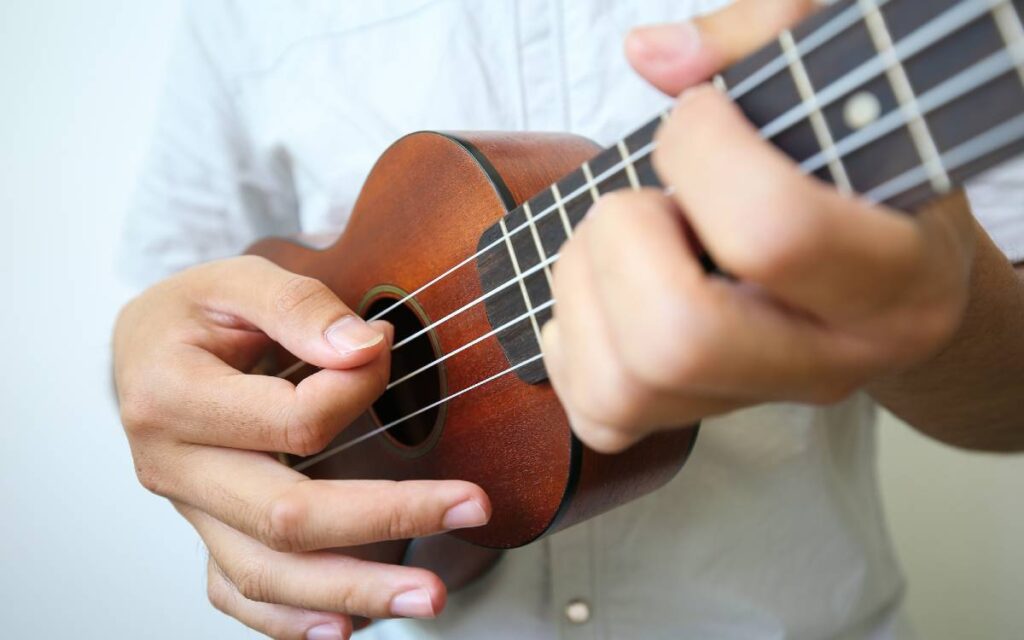Many of us appreciate that the ukulele is a fantastic instrument to accompany singing. In fact, it’s not uncommon to associate the instrument more or less exclusively as something used for accompaniment, and not a solo instrument in its own right – especially because it’s simple to learn to play ukulele chords and strumming patterns.
However, you don’t have to sing to play the ukulele. Instead, you can incorporate creative elements like chord melodies, different strumming patterns, and percussive techniques into your playing to make it more interesting to play and listen to.
If you’d like to buy a ukulele but aren’t a confident singer, you might be wondering ‘do you HAVE to sing to play ukulele?’ Don’t worry – even if you hate singing, we can show you plenty of other ways to have fun with the ukulele.
Post Contents
On Playing the Ukulele Without Singing

Part of the reason that so many people choose the ukulele as a vocal accompaniment is that it is so accessible. The ukulele’s light weight, as well as its small body and neck, make it easy for both kids and adults to handle. There’s a wealth of video lessons online that can teach you how to play your favorite song on the ukulele while you sing along.
But do you have to sing to play ukulele? Not necessarily
Still, you don’t need to sing to enjoy playing the ukulele. It’s an incredible instrument in its own right, with a wealth of techniques that you can employ in order to showcase its depth, as well as the incredible variety of different sounds you can produce with the ukulele. In this article, we cover some of our favorites and give you some advice on learning to sing and play ukulele, if you’re ready to take the plunge.
Make Playing Ukulele Exciting with Chord Melodies

Incorporating chord melodies into your playing is one of the easiest ways to make the ukulele more exciting, even if you don’t sing while performing. In short, a chord melody involves playing both a melodic line and the chord changes of the song at the same time.
The four strings of the ukulele make it considerably easier to play more complex melodic lines than on guitar, for example, which has 6 strings. For the same reason, chord shapes are arguably easier to manage on the ukulele than they are on the guitar. Furthermore, even beginners to the ukulele can give their music new life by introducing melodic lines played as the chords change. Playing a tune with just chords and a melody line sounds very interesting, even if you don’t sing along.
While having a deep, well-grounded foundation in music theory is a great help for arranging chord melody, it isn’t a necessity. There is a wealth of great resources available for free which can help you develop your own chord melodies, like this tutorial by Guido Heistek.
Case Study: Jake Shimabukuro
Jake Shimabukuro is just one example of a fantastic musician whose repertoire centers around the ukulele. He performs a mixture of popular music and original works on the ukulele. By utilizing rhythms and other musical concepts from a wide variety of musical genres, Shimabukuro creates compelling, unique work which is very entertaining to listen to with the ukulele alone.
Hailing from Hawai’i, the birthplace of the ukulele, Shimabukuro makes classic melodies instantly sound recognizable on the ukulele alone, all without singing. It’s largely through the use of chord melodies that he creates arrangements that sound so full and rich.
Here is an example of Shimabukuro’s work; an incredible performance of Queen’s Bohemian Rhapsody. Shimabukuro employs a considerable number of techniques in his arrangement, making it very interesting and exciting to listen to. He experiments with chord melody, strumming, fingerpicking, dynamics, and slides to give the piece a sense of continuous momentum.
Incorporating Different Techniques and Ideas into your Playing
Percussive Techniques
In addition to playing chord melodies, you can also incorporate a wider range of techniques and tricks into your own music or any of your favorite songs to perform. For example, you might like to work some elements of percussion into your ukulele playing. Try drumming on the face or neck of your uke – you’ll be amazed by how many different sounds you can get out of it!
Strumming Styles and Fingerpicking

If you’re looking to expand your toolbox of ukulele techniques and playing styles, then working on fingerpicking is a great way to add a depth of new musical textures and timbres to your arsenal. Fingerpicking is a wonderful way to play melodic lines and sounds especially gentle on the ukulele compared to the guitar.
You can also experiment with different strumming techniques. For example, you might want to try strumming only with your thumb for a softer overall sound, or you could try a flamenco strumming pattern, which has more attack and a slightly percussive nature.
New Voicings and Chord Shapes
There’s more than one way to play the same chord. If you want to really give your ukulele playing some depth, try experimenting with different chord voicings. A voicing is a way to play a particular chord, but different voicings will generally have at least one note that is different from the others. For example, some voicings have more of a ‘jazzy’ quality, due to the notes that make up that particular voicing.
Switching up the voicings you use when playing ukulele is a great way to keep things feeling new and exciting. You can draw upon different atmospheres and moods as you’re strumming away, and you can also tailor your approach to make it more genre-specific. For example, playing jazzier chords on the ukulele will sound much better when playing jazz music than more standard voicings might.
Explore Different Types of Ukuleles

Did you know that there are actually four primary types of ukulele, as well as a huge range of other, less common types? The soprano, tenor, baritone, and concert ukuleles all have their own strengths and unique characteristics. In addition, there are electric ukuleles, bass ukuleles, guitaleles, and more.
Go Beyond Standard Tuning
There is more than one tuning for the ukulele. In fact, each of the different types of ukulele has a number of tunings that you can experiment with to great effect. Each tuning has its own special character and creates unique chord voicings and shapes for you to try, too.
For example, open tunings can create interesting and lush chord voicings. Simply using a tuning that you aren’t used to can force you to think outside of the box and really challenge yourself as a musician. This is a great way to develop your musicianship, as well as keeping the ukulele exciting and fresh.
Try Playing with an Ensemble or Band
Another great way to make playing the ukulele even more rewarding is to start practicing or performing with a band or ensemble. Even if you are a beginner, you can try to follow along with the melody on your uke, or simply play the chord changes to help give the ensemble a bigger sound overall. While the ukulele doesn’t sound like a guitar, you can experiment with taking on the same role that a guitarist would – the results can be surprising!
If you enjoy combining the ukulele with singing but aren’t a confident singer yourself, then you could accompany a vocalist on the ukulele. This can take a lot of the pressure off of you, and you can concentrate on supporting the vocal performance as best you can.
Experiment with Effects and Pedals

A common way for some guitar players to make their music sound bigger and give it more depth is by employing different kinds of effects and sounds into their performances or recordings, usually with effects pedals. While it might not be so common for musicians who play ukulele, we don’t think there’s any reason not to experiment with effects and see how it transforms the music you play.
For example, using a chorus or reverb pedal while practicing can completely change the overall sound of your music. If you play solo but would like to create music with several different components, then you could try using a loop pedal to track parts like the melody, harmony, percussion, and more. In the right hands, a loop pedal can create the effect of a whole band with just one person!
If you’re still not sold on the idea, this video by Got A Ukulele is a great demonstration of some common effects pedals and how they sound when used with an electric ukulele. Effects like overdrive and reverb might not have originally been developed for the ukulele, but they can sound fantastic if you use them well!
Want to Learn to Sing and Play Ukulele, But Don’t Know Where to Start?
Practice Singing and Playing Ukulele at the Same Time
Playing any instrument while singing is trickier than it might initially seem. Hitting that high note is considerably more difficult when you have to worry about keeping good time. As such, if you are planning on learning to sing and play ukulele at the same time, practice is key if you want to sound good.
Even if you can’t sing and play the uke right now, there’s no reason that you can’t practice – you’ll likely see some improvement much sooner than you think. Start singing while strumming through simple chord shapes, or try playing through chord changes while you sing. Choosing a simple, well-known song with an easy strumming rhythm is a great place to start (if you need inspiration, check out our list of beginner-friendly songs for the ukulele).
Spend Some Time Singing Every Day

If you’re not comfortable with how your voice sounds, then you can start small and build up your confidence. If you’re only just beginning to learn to sing, you can hum or sing quietly to yourself while you play the ukulele, or even while you’re doing household chores. Make sure to choose songs that are in the right key for you to sing comfortably.
Learning the Fundamentals of Singing Technique
If you feel uncomfortable with your singing, then it might not be that you lack talent or ability. Many people have never learned the fundamentals of singing properly, which can make an enormous difference to the quality and clarity of your singing voice virtually overnight.
Air support and proper posture can hugely change the power and support behind your singing, for example. These elements of good technique can really open up your range and help your confidence, making it easier for you to feel comfortable singing in front of others.







